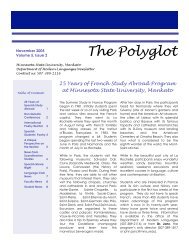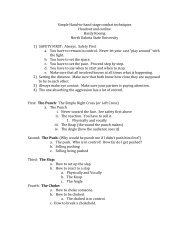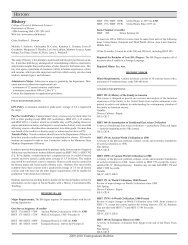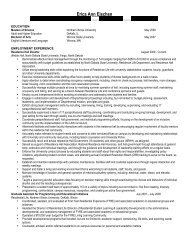TRANSCRIPT OF A PRESENTATION, BY ALAN BADMINGTON, TO ...
TRANSCRIPT OF A PRESENTATION, BY ALAN BADMINGTON, TO ...
TRANSCRIPT OF A PRESENTATION, BY ALAN BADMINGTON, TO ...
You also want an ePaper? Increase the reach of your titles
YUMPU automatically turns print PDFs into web optimized ePapers that Google loves.
As a person who stuttered, I built up a self-image of who I was. Anything<br />
that challenged that image, I perceived as a threat to my well-being. A selfimage<br />
that is too narrow and constrictive to accommodate our entire<br />
personality, imprisons us. It forces us to curtail our activities so that we<br />
may continue to act out of character. Persons who stutter avoid expanding<br />
their comfort zones. Many continue to live their lives doing things with<br />
which they feel comfortable. We cast ourselves in a diminished role and are<br />
content to remain in the same old safe predictable world – maintaining the<br />
status quo.<br />
On the other hand, if we can broaden this self-image to accommodate the<br />
different sides of ourselves, then we are able to play all these roles, and be<br />
comfortable in doing so. The moment you are willing to give up your old<br />
self-image, you will find that there are incredible opportunities for change.<br />
Unless you change you will fight the new you because it does not fit into<br />
how you see yourself.<br />
In order to achieve this, you need to do certain things over and over until<br />
these behaviours become familiar and you get used to seeing yourself in<br />
these new roles. Only then will they become a welcome and acceptable<br />
part of the ‘real’ you. Until permanent changes occur – through continual<br />
expansion – the hexagon will remain vulnerable.<br />
In his book, John Harrison says that he made his stuttering disappear long<br />
before his actual blocking behaviours ceased. He did this by observing<br />
what he was doing in a different light. He says, and I quote, “When I<br />
stopped observing my problem through the narrow perspective of<br />
stuttering; the stuttering per se was gone. That is, I stopped seeing the<br />
behaviour as something called stuttering – and in its place was a handful of<br />
other problems in a unique relationship that needed to be addressed. By<br />
addressing these issues, individually, the actual physical blocking behaviours<br />
slowly diminished and disappeared over time”.<br />
If you do not do anything about your posture of helplessness; or your<br />
reluctance to communicate your feelings; or your lack of self-assertiveness;

















